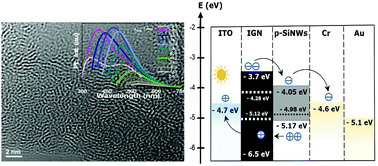Tunable photoluminescence from interconnected graphene network with potential to enhance the efficiency of a hybrid Si nanowire solar cell
Abstract
An interconnected graphene network (IGN) structure with excellent photoluminescence (PL) properties was synthesized using a one-pot microwave-assisted hydrothermal carbonization route. The material exhibited intense and excitation-wavelength dependent PL emission located mainly in the UV-blue light range (300–450 nm). The result demonstrates that graphene networks could also be included in the emerging class of tunable PL carbon nanomaterials. Furthermore, we have taken a first step towards their incorporation into solar cell devices by fabricating IGN/p-SiNWs radial heterojunctions using the versatile potentiostatic electrodeposition technique. The IGN modified p-SiNW solar cell showed the best performance with an overall enhancement of power conversion efficiency of 7.5 times higher than the reference cell. We emphasize that the structural and electronic characteristics of the as-prepared IGN combined with tapering effects are directly responsible for the tripled short circuit current density and 9% improvement of open circuit voltage with respect to the reference cell. Finally, we have demonstrated that the IGN successfully passivated the Si nanowires’ surface using intensity modulated photocurrent/photovoltage spectroscopy (IMPS/IMVS). These promising findings indicate that further IGN exploitation may help to gain efficiency in future energy conversion applications.



 Please wait while we load your content...
Please wait while we load your content...